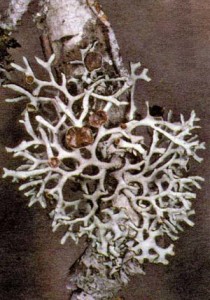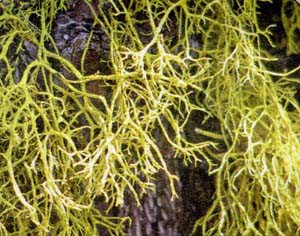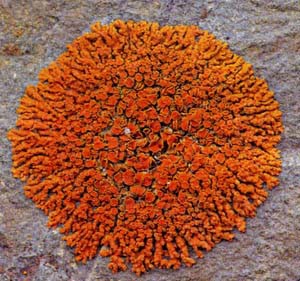Lichen Survey Hits the Jackpot One-Day “BioBlitz” Uncovers 61 Species Not Previously Recorded at Crater Lake
Reflections Visitor Guide
Crater Lake National Park
Summer/Fall 2009
National Park Service
We’ve all seen lichens-they’re everywhere. They grow on tree trunks, branches, cliffs, boulders, and even buildings. They come in a rainbow of colors and a myriad of forms. Yet, despite their beauty and ubiquity, their small stature means they’re often overlooked-even in national parks.
|
Letharia vulpina “Staghorn” or “Wolf Lichen” |
|
Xanthoria elegans “Elegant Sunburst Lichen” |

Hypogymnia imshaugii “Forked Tube Lichen” |
In the summer of 2008, however, 3 lichen experts and 39 volunteers teamed up for a one-day Lichen BioBlitz at Crater Lake National Park to raise awareness of these fascinating organisms arid to catalogue their diversity. On August 23rd, in the course of a 7-hour survey, the investigators nearly doubled the number of lichen species recorded in the park.
A “BioBlitz” is a quick assessment of the number of living things (or a subset of living things) in a particular place. It’s not a complete inventory, but it does indicate the degree of biodiversity in a given area. BioBlitzes provide valuable baseline data and help lay the groundwork for further studies. By enlisting the help of the general public, BioBlitzes also provide opportunities for laypeople to make scientific discoveries and to interact with professional biologists.
Five sampling sites, representing a range of habitats, were chosen for the Lichen BioBlitz: lower Annie Creek, upper Annie Creek, Godfrey Glen, Castle Crest, and Cloudcap. At each site, volunteers collected lichen samples and brought them to a central location, where a lichenologist made preliminary identifications.
Prior to the survey, 64 lichen species had been documented in the park. Remarkably, the BioBlitz volunteers uncovered 61 additional species, bringing the lichen biodiversity list for Crater Lake to 125 species. Based on the day’s findings, lichenologist Rick Demmer predicted that “If we could come back here with more time and check out other kinds of habitat, I suspect the total could nearly be doubled again.”
It’s useful to know which lichens inhabit an area because of their potential as bioindicators. Although lichens are among the hardiest of organisms, capable of living in extreme environments ranging from arctic tundra to desert sand, they a sensitive to environmental pollutants. Keeping tabs on the health of our lichens can help us gauge the health of our park, as well as our planet.
Lichens are also valuable for other reasons: they stabilize the soil, provide food for animals, and furnish nesting material for birds. Even though many lichens grow on trees, they are not parasitic. They derive moisture and nutrients from the atmosphere and produce their own food through photosynthesis.
But don’t be fooled-lichens aren’t exactly plants. They are composite organisms, made up of several species that live and work together in a symbiotic (mutually beneficial) relationship. Typically, the union is between a fungus and an alga. The fungus provides structure and protection for the alga; the alga manufactures food for the fungus.
It’s a successful partnership-much like the one between BioBlitz biologists and volunteers. Biologists provide the expertise needed for species identification; volunteers provide the manpower needed to canvass a large area in a short amount of time.
The 2008 Lichen BioBlitz was sponsored by the park’s Science and Learning Center. The center also organized the park’s first BioBlitz, a 2007 plant survey of Sphagnum Bog, a wetland on the western edge of the park. The park’s next BioBlitz is scheduled for 2010. Check the park’s website (www.nps.gov/crla/slc.htm) in the summer of 2010 for information on volunteering.
In the meantime, as you walk through the park this summer, take a moment to notice and appreciate the varied assortment of lichens-hidden in plain sight-on the cliffs, tree trunks, branches, buildings, and rocks beneath your feet.
Other pages in this section
- Government will buy $1 million of land in Siskiyou monument – October 30, 2009
- OIT Environmental Science Students Learn at Crater Lake – Oct. 22, 2009
- Three missing people found: hunters, mushroom hunter located Saturday – October 18, 2009
- Crater Lake Wilderness: Oregon’s ‘best idea’ needs protection – October 17, 2009
- Wet weather ends fire season around region – October 13, 2009
- Roosevelt historian: He was a ‘thinker’; Brinkley will share stories from new book inaugural lecture – October 12, 2009
- Prescribed burn postponed at Crater Lake: Park Service to wait until forecasts are more favorable – October 9, 2009
- Prescribed burns set for next few months: Agencies will burn nearly 15,000 acres, mostly in Jackson, Josephine counties – October 9, 2009
- Search exercise to cover area where boy was lost – September 11, 2009
- National Park Service Announces Appointment of Dr. Gary Machlis as Science Advisor to the Director – August 12, 2009
- Extra pair pays off in Crater Lake Rim Runs – August 9, 2009
- Wilderness proposed at Crater Lake – August 07, 2009
- Oregon Wild warns legal action on Crater Lake helicopters – August 6, 2009
- Cantwell: Jarvis Well-Qualified for the ‘Greatest Job in the World’ – July 28, 2008
- Senator Wyden issues statement condemning Crater Lake National park helicopter tours – July 27, 2009
- Desert Ridge Wildland Fire continues burning at Crater Lake National Park – July 21, 2009
- Whitney Wildland Fire nears containment at Crater Lake National Park – July 21, 2009
- Cameron (Cam) Sholly has been selected as the new superintendent of Natchez Trace Parkway – July 15, 2009
- Rep. Dicks supports Jon Jarvis for nomination of National Park Service Director – July 10, 2009
- USGS volcanologist Charles Bacon gives Mount Mazama geologic history talk – June 23, 2009
- USGS volcanologist Charles Bacon receives award at Crater Lake National Park – July 8, 2009
- Review: Geologic Map of Mount Mazama and Crater Lake Caldera, Oregon by Charles R. Bacon – July 7, 2009
- Free entrance weekends at Crater Lake National Park – June 20, 2009
- Oregon Congressman Proposes “Aerial Gondola” to Wizard Island – Summer/Fall 2009
- A Conversation with the Park’s Chief of Terrestrial Ecology – Summer/Fall 2009
- Black Bear Census Set to Begin: Park to Estimate Population Using Hair Samples and DNA – Summer/Fall 2009
- A promise fulfilled on roadless forests – May 28, 2009
- Crater Lake Lodge opens for 2009 season – May 21, 2009
- Marcella Isabella Stine (1918 – 2009) – May 22, 2009
- Lawrence Campbell Merriam Jr. (1923 – 2008) – May 22, 2009
- Wayne R. Howe: 1920 – 2008 – May 21, 2009
- Passing of John Bowdler (1925 – 2009) – May 4, 2009
- Parks receive stimulus funds: Crater Lake, Lava Beds to use funding for improvements – April 24, 2009
- Mercy Flights makes life-saving donation to Crater Lake park – February 24, 2009
- Rescue at Crater Lake: specialized rescue team saves man from icy slope – February 2, 2009
- Former National Park Service director George B. Hartzog Jr. dies – January 31, 2009
- Ski patrol member watches over park: Niel Barrett is a charter member of the ski patrol at Crater Lake National Park – January 30, 2009
- Paradise in Blue: Snowshoe trek at Crater Lake informative, easy, free – January 22, 2009




